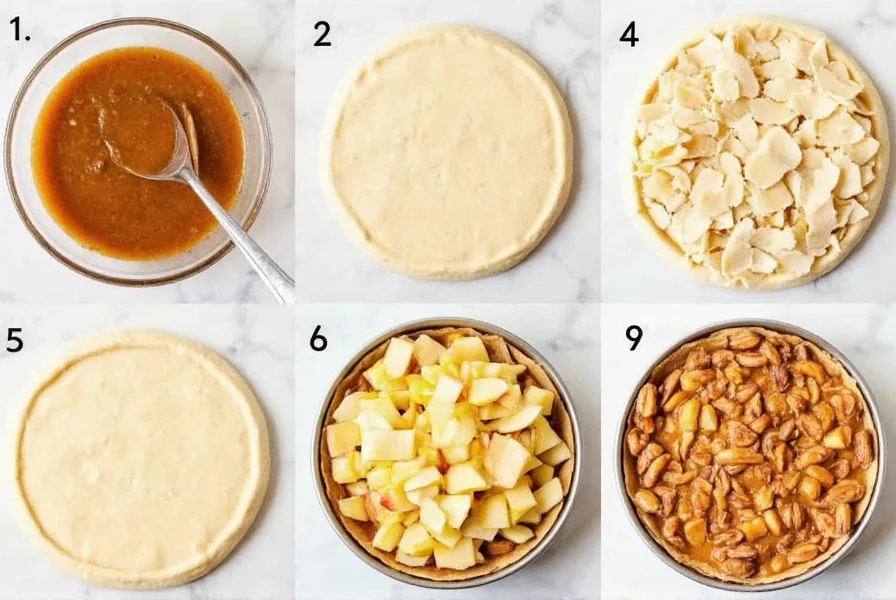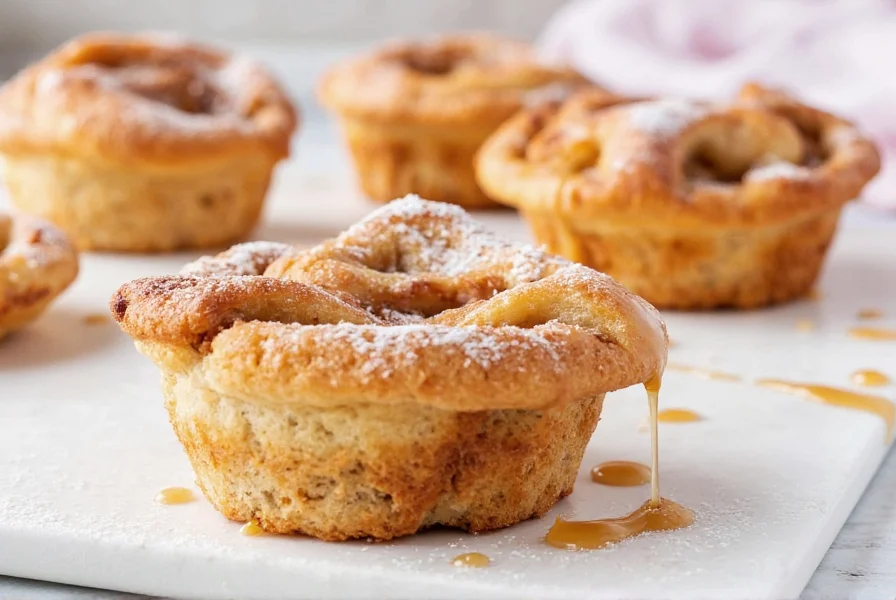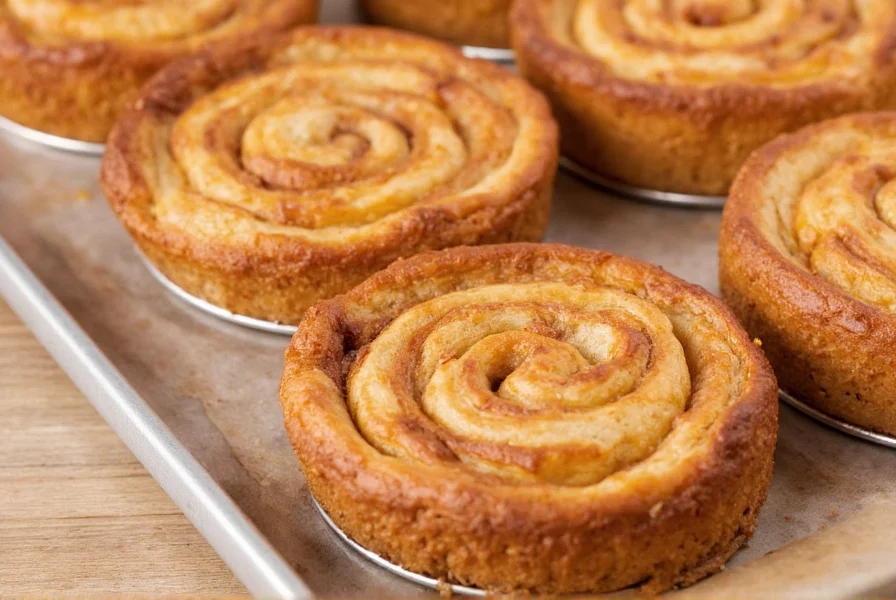Cinnamon roll apple pies are a creative dessert hybrid that combines the flaky, layered texture of cinnamon rolls with the warm apple filling of traditional pies. This innovative treat features rolled pastry filled with spiced apples, then shaped into individual spiraled portions that bake up with a gooey cinnamon-apple center and golden, pull-apart layers. The result is a perfect marriage of two classic desserts that delivers the comforting flavors of fall in an easy-to-serve format.
For home bakers seeking the ultimate comfort dessert, cinnamon roll apple pies offer the best of both worlds. This innovative recipe transforms traditional pie filling into an individualized, pull-apart treat that maintains the flaky layers of cinnamon rolls while delivering the familiar warmth of apple pie. Unlike standard pies that require slicing, these portion-controlled delights separate naturally at the table, making them ideal for gatherings and holiday meals.
What Makes Cinnamon Roll Apple Pies Special
The magic of cinnamon roll apple pies lies in their structural innovation. By incorporating diced apples into the classic cinnamon roll filling and wrapping them in layered pastry, you create a dessert with multiple textural experiences in every bite. The outer layers become crisp and golden while the interior remains tender with a caramelized apple-cinnamon filling. This hybrid approach solves common pie problems like soggy bottoms while maintaining the beloved flavor profile.
Essential Ingredients for Perfect Results
Creating exceptional cinnamon roll apple pies requires attention to ingredient quality and preparation techniques. For the best cinnamon roll apple pie filling, select firm baking apples like Honeycrisp or Granny Smith that hold their shape during baking. The ideal ratio combines two parts apple to one part cinnamon-sugar mixture, with a touch of lemon juice to balance sweetness.
| Ingredient | Function | Recommended Quantity |
|---|---|---|
| All-purpose flour | Structure foundation | 2 ½ cups |
| Cold unsalted butter | Flakiness creator | 1 cup (2 sticks) |
| Firm baking apples | Flavor and texture | 3 cups diced |
| Ground cinnamon | Signature spice | 2 tablespoons |
Professional bakers emphasize that the butter temperature is critical for achieving proper lamination. Many successful cinnamon roll apple pie for beginners recipes use puff pastry as a time-saving alternative while still delivering excellent results.

Step-by-Step Preparation Guide
Creating homemade cinnamon roll apple pies follows a straightforward process when you understand the key techniques:
- Prepare the pastry: Either make your own dough or use quality store-bought puff pastry. If making from scratch, keep all ingredients cold and handle minimally.
- Cook the apple filling: Sauté diced apples with butter, sugar, cinnamon, and a touch of cornstarch until slightly softened but still holding shape.
- Roll and fill: Roll pastry into a large rectangle, spread with apple filling, then roll tightly like a jelly roll.
- Slice and arrange: Cut into 1½-inch slices and place cut-side down in a greased baking dish.
- Bake to perfection: Bake at 375°F for 25-30 minutes until golden brown and bubbling.
The ideal cinnamon roll apple pie bake time varies based on your oven and pastry thickness. Look for visual cues rather than strictly following timers—golden brown tops and bubbling filling indicate readiness. Many bakers recommend letting the pies rest for 10-15 minutes after baking to allow the filling to set slightly.
Avoiding Common Mistakes
Even experienced bakers encounter challenges with cinnamon roll apple pie with puff pastry. The most frequent issues include:
- Soggy bottoms: Prevent this by pre-baking the bottom layer for 5 minutes or using a small amount of breadcrumbs in the filling to absorb excess moisture
- Falling apart during rolling: Chill the pastry for 15 minutes before rolling to make it more manageable
- Overly sweet filling: Balance sweetness with lemon juice and consider reducing sugar if using naturally sweet apple varieties
Creative Variations to Try
Once you've mastered the basic technique, experiment with these popular cinnamon roll apple pie dessert ideas:
- Streusel topping: Add a crumb topping before baking for extra texture
- Cheese infusion: Mix cream cheese into the filling for a cinnamon roll-inspired twist
- Glaze options: Drizzle with maple glaze, caramel sauce, or classic cream cheese frosting after baking
- Seasonal additions: Incorporate cranberries, pecans, or dried cherries for holiday variations

Serving and Storage Recommendations
For optimal enjoyment, serve cinnamon roll apple pies warm with a scoop of vanilla ice cream. The contrast of temperatures enhances the flavors and creates a restaurant-quality presentation at home. Proper cinnamon roll apple pie storage tips include:
- Store cooled pies in an airtight container at room temperature for up to 2 days
- Refrigerate for up to 5 days, reheating individual portions in the oven for best texture
- Freeze unbaked portions for up to 3 months—bake from frozen with additional 10-15 minutes
Unlike traditional pies that often improve overnight as flavors meld, cinnamon roll apple pies are best enjoyed fresh when the pastry maintains its distinct layers. Reheating in a 300°F oven for 8-10 minutes restores that just-baked quality.
Frequently Asked Questions
Can I use canned apple pie filling for cinnamon roll apple pies?
While fresh apples produce superior texture and flavor, you can use canned apple pie filling in a pinch. Drain excess liquid thoroughly and reduce added sugar in your cinnamon mixture since canned filling is typically sweeter than homemade. For the best cinnamon roll apple pie filling, fresh apples provide better structural integrity during baking.
How do I prevent my cinnamon roll apple pies from becoming too dry?
To maintain moisture in your cinnamon roll apple pies, ensure your apple filling includes enough natural juices by not overcooking the apples before assembly. Brushing the cut sides with melted butter before baking also helps retain moisture. If using puff pastry, avoid overbaking—remove when golden but still slightly soft to the touch, as they'll continue cooking from residual heat.
What's the ideal apple variety for cinnamon roll apple pies?
The best cinnamon roll apple pie filling combines firm baking apples that hold their shape. Honeycrisp offers perfect sweetness and texture, while Granny Smith provides necessary tartness to balance the cinnamon. Many professional bakers recommend a 50/50 mix of these varieties for optimal flavor complexity and structural integrity during baking.
Can I make cinnamon roll apple pies ahead of time?
Yes, you can prepare cinnamon roll apple pies ahead of time. Assemble and slice the rolls, then freeze them on a baking sheet before transferring to an airtight container. When ready to bake, place frozen portions directly in the oven, adding 10-15 minutes to the cinnamon roll apple pie bake time. This method preserves the layered structure better than refrigerating assembled pies.
What's the difference between cinnamon roll apple pies and regular apple cinnamon rolls?
Traditional apple cinnamon rolls feature apple pieces mixed into the cinnamon-sugar filling, while cinnamon roll apple pies reverse this concept—using pie-style apple filling as the primary component wrapped in layered pastry. The pie version typically contains more apple relative to pastry and often incorporates pie spice elements like nutmeg and allspice for authentic pie flavor in a roll format.











 浙公网安备
33010002000092号
浙公网安备
33010002000092号 浙B2-20120091-4
浙B2-20120091-4